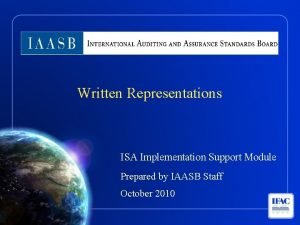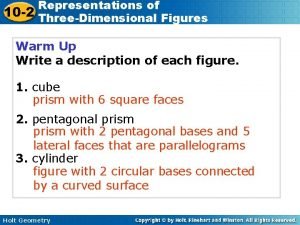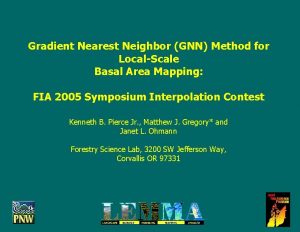Representations of place A localscale casestudy David Redfern













- Slides: 13

Representations of place A local-scale case-study David Redfern Philip Allan Publishers © 2016

Sturton Le Steeple, Nottinghamshire Philip Allan Publishers © 2016 David Redfern

What’s in a name? Sturton Le Steeple is a small village in north Nottinghamshire which most of you will not have heard of. When approaching the village by road you pass the name sign on the previous slide. It is shown again on the following slide, but before we look again, what can you suggest about the village from its name? § Sturton The suffix ‘-ton’ tells you that the place is of Saxon origin – i. e. its historical time period is between the Romans and the Normans. § Le Might suggest there is a French connection. § Steeple Might suggest that there is a church with a steeple. Philip Allan Publishers © 2016

What’s in a picture? If we look again at the road sign, what can we see? § To the left there appears to be a Roman soldier — a centurion perhaps? § To the right there is a man with a black coat, a black cone-shaped hat, with a white collar and white cuffs on his shirt. § In the middle there is a church with a tower, but with several small steeples § Between the two figures are various spellings of Sturton — ‘Estretone’ and ‘Styrton’ — perhaps suggesting the name of the village has changed over time. We can now perhaps work out a little more about the village from this representation. Philip Allan Publishers © 2016

The historical story (1) The Romans built a road (known as Ermine Street) from Lincoln (Roman name Lindum) to York (Roman name Eboracum). This road crossed the River Trent 2 miles (3 km) southeast of Sturton Le Street. The road crossed the marsh on a small embankment in a northwesterly direction and a village grew up on a dry point to which the name Estretton (the town on the street) was given. Much later, it is possible that Harold the Saxon used the road on his way to fight William the Conqueror (a Frenchman) near Hastings in 1066. Indeed the latter could himself have headed on the road through the village when he came north to take York in 1069. Philip Allan Publishers © 2016

Ermine Street today (now called North Street) David Redfern Philip Allan Publishers © 2016

The historical story (2) Over time the village changed its name several times, but by 1823 it had become Sturtonen-le-Steeple. Perhaps the main reason for this wasthe construction of the fine church in the village, dedicated to St Peter and St Paul, which has a magnificent set of small steeples, on a tower. Another important historical connection is that Pastor John Robinson was born in Sturton Le Steeple in 1576. John Robinson was the founder of the Pilgrim Fathers who sailed to North America in the Mayflower. Philip Allan Publishers © 2016

The ‘steeple’ of Sturton Le Steeple David Redfern Philip Allan Publishers © 2016

What does this mean for the village? The village lies between Retford and Gainsborough. It is clear that Nottinghamshire County Council has represented the place on the road sign for the village in a way intended to encourage people to visit. The area is a popular destination for tourists from the USA, who often have a religious purpose. Other visitors include archaeologists, amateur and professional, seeking evidence of activity by the Romans in the area. Philip Allan Publishers © 2016

What of the people of the village? Sturton Le Steeple England Male (%) 48. 7 49. 2 Female (%) 51. 3 50. 8 0– 14 (%) 16. 3 17. 7 The high proportion of local residents who are of retirement age creates considerable issues that the local council must address. 15– 29 (%) 13. 5 18. 8 30– 44 (%) 18. 1 20. 6 What would be their views on the village’s representation and the possible increasing numbers of visitors to the village? 45– 64 (%) 31. 8 25. 4 65 and over (%) 20. 2 16. 4 Sturton’s population is predominantly in the age group of 45 and over. Current data suggest that this proportion may increase further in the foreseeable future, in line with regional and national trends. This might be expected owing to the rural nature of the village. Philip Allan Publishers © 2016 Population characteristic (2011) Age (years)

Fieldwork opportunities (1) There a number of ways in which fieldwork can be based on representation of place. Examples include: § Researching the community assets of the village. How are they used; do they assist in developing, maintaining or enhancing the representation of the place? § Researching the employment structure of the place. Is any employment linked to the representation, and could more employment opportunities arise? Philip Allan Publishers © 2016

Fieldwork opportunities (2) Another form of research would be to use a questionnaire, or a series of interviews, to ascertain the views and opinions of residents about the representation as given. For example: § What facilities exist to support the representation of the village? § What facilities could be created? § What design features either enhance or work against the representation? § What new design features could be incorporated? § What else could be incorporated to improve the wellbeing of residents? § What other forms of media — paintings, literary works, music, video — provide a representation of the place? Try out some or all of the ideas in this presentation for a local place you know well. Philip Allan Publishers © 2016

This resource is part of GEOGRAPHY REVIEW, a magazine written for A-level students by subject experts. To subscribe to the full magazine go to: http: //www. hoddereducation. co. uk/geographyreview Philip Allan Publishers © 2016
 David redfern geography
David redfern geography 574 in expanded form
574 in expanded form Disturbance that transfers energy from place to place
Disturbance that transfers energy from place to place Millions billions trillions chart
Millions billions trillions chart Waves are repeating disturbances that transfer
Waves are repeating disturbances that transfer Mathematical literacy floor plans
Mathematical literacy floor plans Isa 580 written representations summary
Isa 580 written representations summary Elevation map maths lit
Elevation map maths lit Nonlinguistic representation definition
Nonlinguistic representation definition Efficient estimation of word representation in vector space
Efficient estimation of word representation in vector space Cultural representations and signifying practices
Cultural representations and signifying practices Representations of three dimensional figures
Representations of three dimensional figures Scale maths lit
Scale maths lit Simplified representations of complex economic activities
Simplified representations of complex economic activities
























